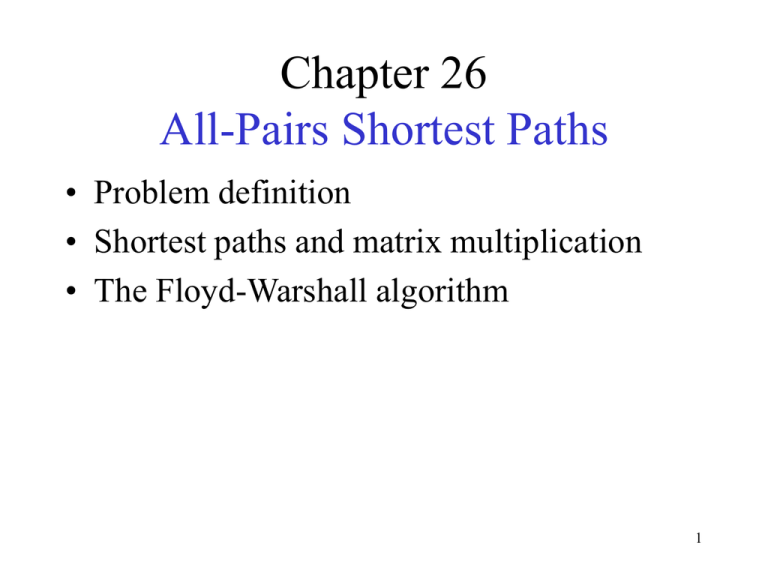chapter26
advertisement

Chapter 26
All-Pairs Shortest Paths
• Problem definition
• Shortest paths and matrix multiplication
• The Floyd-Warshall algorithm
1
Problem definition:
• Real problem:When to make a table of distances between
all pairs of cities for a road atlas,how can we compute the
distances?
• Model the problem:
• Given a weighted,directed graph G=(V,E) with a weight
function w:E
R that maps edges to real-valued weights.
• For every pair of vertices u,v V, find a shortest(least
weight) path from u to v, where
the weight of a path is the
sum of the weights of its constituent edges.
2
Solve the problem by SingleSource shortest paths algorithm:
• If all edge weights are nonnegative, we can use Dijkstra’s
algorithm.
• If negative-weight edges are allowed, then we use
Bellman-Ford algorithm instead.
• Can you analysis the complexity of the two solutions ? Is it
possible for us to find a more efficient algorithm?
3
Preliminary knowledge:
• In this chapter, we use an adjacency-matrix representation:
• wij= 0
if i=j
•
the weight of directed edge (i,j) if i j and (i,j) E
•
if i j and (i,j) E
• The output of the algorithm presented in this chapter is an
n*n matrix D=(dij),where entry dij contains the weight of a
shortest path from vertex i to vertex j. That is , if we let (i, j )
denotes the shortest-path weight from vertex i to vertex j,
then dij= (i, j ) at termination.
4
Continue:
• To solve the all-pairs shortest-paths problem on an input
adjacency matrix, we need to compute not only the shortest
path weights but also a predecessor matrix = ( ij),
where ij is NIL if either i=j or there is no path from i to j,
and otherwise ij is some predecessor of j on a shortest
path from i.
• The subgraph induced by the ith row of the matrix
should be a shortest-paths tree with root i. For each vertex i
V,we define the predecessor subgraph of G for i as G ,i
=(V ,i,E ,i)
• V ,i={j V: i,j NIL}{i}
5
• E ,i={( ij , j): j V,i and ij NIL}
Shortest paths and matrix
multiplication:
• This section presents a dynamic-programming algorithm
for the all-pairs shortest-paths problem on a directed graph
G=(V,E). Each major loop of the dynamic program will
invoke an operation that is very similar to matrix
multiplication, so that the algorithm will look like repeated
matrix multiplication. We shall start by developing a
(V4)-time algorithm for the all-pairs shortest-paths problem
and the improve its running time to (V3lgV).
6
Review: the steps to develop a
dynamic-programming algorithm
• Characterize the structure of an optimal solution.
• Recursively define the value of an optimal solution.
• Computing the value of an optimal solution in a bottom-up
fashion.
• Constructing an optimal solution from computed
information.
7
The structure of a shortest path:
• Consider a shortest path p from vertex i to vertex j, and
suppose that p contains at most m edges.Assuming that
there are no negative-weight cycles,m is finite.If i=j,then p
has weight 0 and no edges.If vertices i and j are distinct,
p'
then we decompose path p into i k
j,where path
p’ now contains at most m-1 edges.Moreover, p’ is a
shortest path from i to k. Thus, we have (i, j ) (i, k )
+wkj.
8
A recursive solution to the allpairs shortest-paths problem:
• Now,let dij(m) be the minimum weight of any path from
vertex i to vertex j that contains at most m edges.When
m=0,there is a shortest path from i to j with no edges if and
only if i=j.For m>=1,we compute dij(m) as the minimum of
dij(m-1) (the weight of the shortest path from i to j consisting
of at most m-1 edges) and the minimum weight of any path
from i to j consisting of at most m edges,obtained by
looking at all possible predecessors k of j.Thus,we
recursively define:
(m-1)+w })= min {d (m-1)+w }.
• dij(m)=min ( dij(m-1), 1min
kj
ik
kj
k n {dik
1 k n
9
Continue:
• If the graph contains no negative-weight cycles,then all
shortest paths are simple and thus contain at most n-1
edges.A path from vertex i to vertex j with more than n-1
edges cannot have less than a shortest path from i to j.The
actual shortest-path weights are therefore given by
• (i, j ) =dij(n-1)=dij(n)=dij(n+1)=...
10
Computing the shortest-path
weights bottom up:
• We compute the shortest-path weights by extending
shortest paths edge by edge.Letting A*B denote the matrix
“product” returned by EXTEND-SHORTESTPATH(A,B) .We compute the sequence of n-1 matrices:
• D(1)=D(0)*W=W,
• D(2)=D(1)*W=W2,
• …
• D(n-1)=D(n-2)*W=Wn-1.
• As we argued above, the matrix D(n-1)=Wn-1 contains the
shortest-path weights.So we get the algorithm.
11
Continue:
•
•
•
•
•
•
SLOW-ALL-PAIRS-SHORTEST-PATH(W)
n
rows[W]
D(1)
W
for m
2 to n-1
do D(m)
EXTEND-SHORTEST-PATHS(D(m-1),W)
return D(n-1)
12
Continue:
•
•
•
•
•
•
•
•
•
EXTEND-SHORTEST-PATH(D,W)
n
rows[D]
let D’=(dij’) be a n*n matrix
for i
1 to n
do for j
1 to n
do dij’
for k
1 to n
do dij’
min(dij’,dik+wkj)
return D’
13
Example:
• Figure 1
2
4
3
1
3
8
1
-4
2
7
5
6
-5
4
14
0 3 8 4
0 1 7
4 0
(1)
D =
2 5 0
6 0
8 2 4
0 3
3 0 4 1 7
D(2)= 4 0 5 11
2 1 5 0 2
8 1 6 0
0 3 3 2 4
3 0 4 1 1
7 4
0 5 11
D(3)=
2 1 5 0 2
8 5
1
6
0
0 1 3 2 4
3 0 4 1 1
7 4
0
5
3
(4)
D =
2 1 5 0 2
8 5
1
6
0
15
Improving the running time:
• Our goal,however, is not to compute all the D(m) matrices:
we are interested in matrix D(n-1).Recall that in the absence
of negative-weight cycles, D(m)=D(n-1),for all integers
m>=n-1.So, we can compute D(n-1) with only lg(n 1)
matrix products by computing the sequence:
• D(1)=W,
• D(2)=W2=W*W
• D(4)= W2* W2
• …
• D(2 lg(n 1) )=W2lg(n 1) =W2 lg(n 1)-1 * W2 lg(n 1) -1
16
Continue:
•
•
•
•
•
•
•
FASTER-ALL-PAIRS-SHORTEST-PATHS(W)
n
rows[W]
D(1)
W
while n-1>m
do D(2m)
EXTEND-SHORTEST-PATHS(D(m),D(m))
m
2m
return D(m)
17
Floyd-Warshall algorithm:
• In this section, we shall use a different dynamicprogramming formulation to solve the all-pairs shortestpaths problem on a directed graph G=(V,E).The resulting
algorithm, known as the Floyd-Warshall algorithm, runs in
3) time. As before, negative-weight edges may be
(V
present, but we shall assume that there are no negativeweight cycles.
18
The structure of a shortest path:
• In the Floyd-Warshall algorithm, we use a different
characterization of the structure of a shortest path than we
used in the matrix-multiplication-based all-pairs
algorithms.The algorithm considers the “intermediate”
vertices of a shortest path, where an intermediate vertex of
a simple path p=<v1,v2,…,vl> is any vertex of p other than
v1 or vl, that is, any vertex in the set {v2,v3,…,vl-1}
19
Continue:
• Let the vertices of G be V={1,2,…,n}, and consider a
subset {1,2,…,k} of vertices for some k.For any pair of
vertices i,j V,consider all paths from i to j whose
intermediate vertices are all drawn from {1,2,…,k},and let
p be a minimum-weight path from among them.The FloydWarshall algorithm exploits a relationship between path p
and shortest paths from i to j with all intermediate vertices
in the set {1,2,…,k-1}.
20
Continue:
• The relationship depends on whether or not k is an
intermediate vertex of path p.
• If k is not an intermediate vertex of path p, then all
intermediate vertices of path p are in the set {1,2,…,k-1}.
Thus, a shortest path from vertex i to vertex j with all
intermediate vertices in the set {1,2,…,k-1} also a shortest
path from i to j with all intermediate vertices in the set
{1,2,…,k}.
• If k is an intermediate vertex of path p,then we break p
p1
p2
down into i k j as shown Figure 2.p1 is a
shortest path from i to k with all intermediate vertices in
21
the set {1,2,…,k-1}, so as p2.
All intermediate vertices in {1,2,…,k-1}
p1
i
k
p2
j
P:all intermediate vertices in {1,2,…,k}
Figure2 Path p is a shortest path from vertex i to vertex j,and
k is the highest-numbered intermediate vertex of p. Path p1,
the portion of path p from vertex i to vertex k,has all intermediate
vertices in the set {1,2,…,k-1}.The same holds for path p2 from
vertex k to vertex j.
22
A recursive solution to the allpairs shortest paths problem:
• Let dij(k) be the weight of a shortest path from vertex i to
vertex j with all intermediate vertices in the set {1,2,…,k}.
A recursive definition is given by
• dij(k)= wij
if k=0,
•
min(dij(k-1),dik(k-1)+dkj(k-1))
if k 1.
• The matrix D(n)=(dij(n)) gives the final answer-dij(n)= (i, j )
for all i,j V-because all intermediate vertices are in the
set {1,2,…,n}.
23
Computing the shortest-path
weights bottom up:
•
•
•
•
•
•
•
FLOYD-WARSHALL(W)
n
rows[W]
D(0)
W
for k
1 to n
do for i
1 to n
do for j
1 to n
dij(k)
min(dij(k-1),dik(k-1)+dkj(k-1))
• return D(n)
24
Example:
• Figure 3
2
4
3
1
3
8
1
-4
2
7
5
6
-5
4
25
0 3 8 4
0 1 7
4 0
(0)
D =
2 5 0
6 0
1
NIL 1
NIL 1
2
NIL NIL NIL 2
NIL 3
NIL
NIL
NIL
(0)
=
NIL 4
NIL NIL
4
NIL NIL NIL 5
NIL
0 3 8 4
0 1 7
4 0
D(1)=
2 5 5 0 2
6 0
1
NIL 1
NIL 1
2
NIL NIL NIL 2
(1)= NIL 3 NIL NIL NIL
1
4
NIL 1
4
NIL NIL NIL 5
NIL
26
0 3 8
0
4 0
(2)
D =
2 5 5
4 4
1 7
5 11
0 2
6 0
1
2
1
NIL 1
2
NIL NIL NIL 2
NIL 3
NIL
2
2
(2)
=
1
4
NIL 1
4
NIL NIL NIL 5
NIL
8
0 3
0
4
0
(3)
D =
2 1 5
4 4
1 7
5 11
0 2
6 0
1
2
1
NIL 1
2
NIL NIL NIL 2
(3)= NIL 3 NIL 2 2
3
4
NIL 1
4
NIL NIL NIL 5
NIL
27
0 3 1 4 4
3 0 4 1 1
7 4
0
5
3
(4)
D =
2 1 5 0 2
8 5
1 6 0
4
2
1
NIL 1
NIL 4
2
1
4
4
3
NIL
2
1
(4)
=
3
4
NIL 1
4
4
3
4
5
NIL
0 1 3 2 4
3 0 4 1 1
7 4
0 5 3
D(5)=
2 1 5 0 2
8 5
1
6
0
4
5
1
NIL 3
NIL 4
2
1
4
(5)= 4 3 NIL 2 1
3
4
NIL 1
4
4
3
4
5
NIL
28
The End:
29






